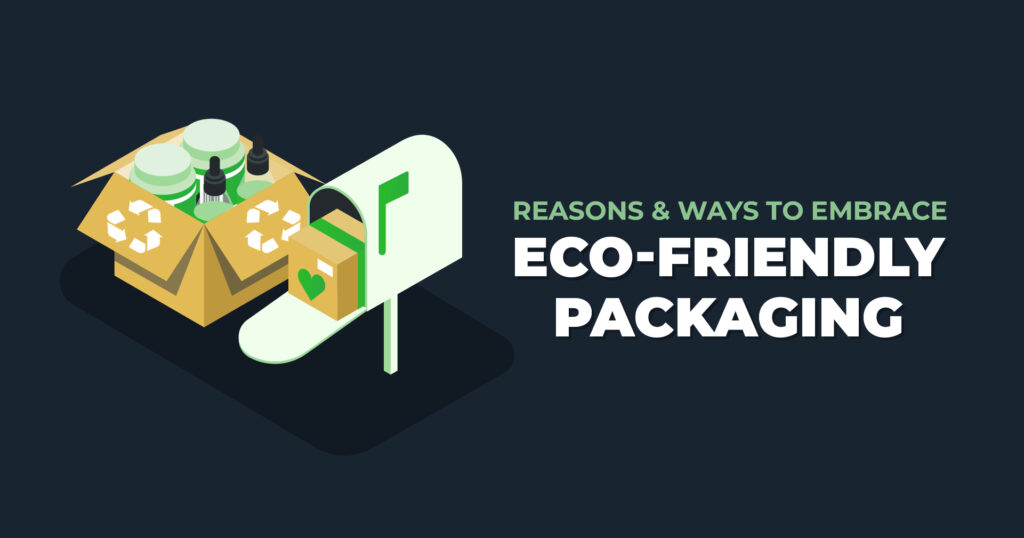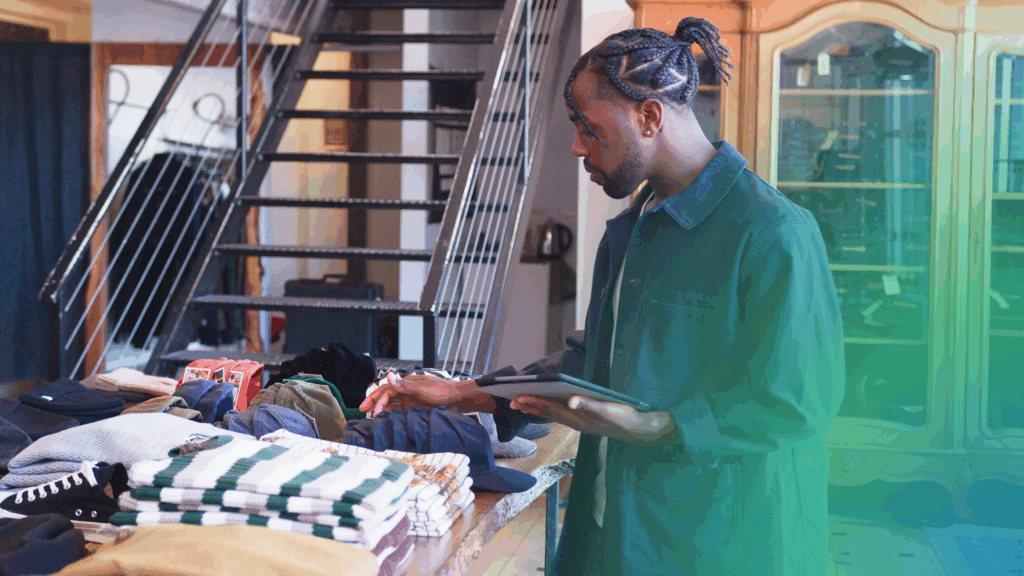In a recent blog post, we discussed the environmental cost of ecommerce and ways to offset it. Packaging, as we all know, is one of the worst offenders, but it’s also one of the easiest environmental costs to reduce. So, for ecommerce owners who want to reduce their impact on the environment, eco-friendly packaging is a great place to start. Today we’re going to delve a little deeper into the sustainable, eco-friendly packaging options available, and decide which ones to embrace for the future.
Reasons to Embrace Eco-Friendly Packaging
in order to ensure that ecommerce orders arrive undamaged, a certain amount of packaging is necessary. Yet, according to the EPA, 28% of municipal solid waste is containers and packaging materials. If we can’t eliminate packaging, we owe it to the earth to make it as eco-friendly as possible. Here are a few reasons to embrace eco-friendly packaging now, rather than waiting until you’re forced to do so.
1. It’s easy
We can’t change the fact that ecommerce orders need to be packed and shipped from fulfillment centers to our customers’ doorsteps. But we can change the way they’re packaged. New types of packaging are developed every day that are recyclable, reusable, biodegradable and compostable, while offering the same protection as single-use plastics.
2. It’s So Extra
Most products come already packaged from the manufacturer, whether in their own custom boxes or poly bags. During the ecommerce fulfillment process, the product is packaged a second time, in a ship-ready box or mailer, often surrounded by air pillows, bubble wrap or packing peanuts to protect it from rough handling during the shipping process. It’s a double whammy. The customer then has to recycle, reuse, or dispose of this extra packaging, in addition to the original packaging.
3. Plastics Are Forever
Many types of plastic are recyclable, and can be recycled over and over again. Other types of plastic are non-recyclable. These single-use plastics include bubble wrap, Styrofoam, poly bags, air pillows and plastic wrap. Keeping track of which ones are recyclable is confusing for consumers, and as a result, most plastics don’t get recycled. According to the EPA, only 8.7% of the 35 million tons of plastic waste were recycled in 2018. The fact is, all plastics eventually end up in a landfill where they very, very slowly degrade, giving off greenhouse gasses as they do so, which further damages the environment; or worse, they end up floating in our oceans, where sunlight breaks them down into microplastics that somehow work their way into our bloodstreams.
4. It’s Becoming the Law
One by one, countries, states, counties, and cities have enacted laws that ban single use plastics including polystyrene (Styrofoam), plastic bags, and plastic straws. More laws are sure to follow. It’s only a matter of time before non-recyclable plastic packaging is banned entirely, but you get extra credit for doing it now.
5. Because you care
You wouldn’t be reading this article if you didn’t care. Increasingly, your customers also care, and that’s a good sign for our environment.
Where to Start?
In the world of waste management, there is a hierarchy of priorities that’s helpful when looking at reducing your impact on the environment. At the top of the list is simply reducing the amount of waste (in this case, packaging) you use. Once you’ve reduced as much as you can, your priorities should shift to using the least harmful types of packaging that meet your needs. The hierarchy of priorities suggests looking at reusable materials first, followed by recyclable, compostable, waste-to-energy, (waste that is burned in power plants to produce energy), and landfill-bound materials, in that order.
Source: ecoenclose.com
Less is More
Of course, your first priority is to protect your products against damage during shipping and handling. So, the first question to ask is whether you can reduce the amount of packaging it takes to accomplish this goal. Apparel, for example, doesn’t need cushioning but does need protection against rain or snow. If your organic tees come from the manufacturer in a poly bag, do they really need a waterproof shipping mailer? As another example, a multi-part product that must be assembled by the consumer requires a lot of engineering to fit all the parts into the smallest possible package, with enough packing materials to prevent parts from shifting, scratching or each other in transit. Consider that if the parts are packed securely enough, you may not need an exterior package for shipping. Consider that when India banned single use plastics in 2022, Amazon India found that they could ship roughly 40 percent of orders in their original boxes, without an outer box or other packaging.
Lastly, if your orders do require extra packaging, consider whether they could be packed more densely into a smaller container. This not only reduces waste, but also reduces shipping costs and carbon emissions per order. A good 3PL fulfillment partner can help you reduce package sizes and source eco-friendly materials at the same time.
Avoid Single-Use Materials
Single-use packing materials, such as bubble wrap, poly bags, and Styrofoam peanuts could be reused by eco-conscious consumers, but most likely will wind up in a landfill. Therefore, if you must use plastic, recycled and recyclable plastic is always a better choice than single-use plastic. Back to the apparel example, could your manufacturer source a sustainable, yet water-resistant alternative to the poly bag — a compostable bag, perhaps, or a bag made from recycled plastic? Recyclable plastics include PET, HDPE, PVC, LDPE and PP.
Bioplastic is Still Plastic
Bioplastic or biodegradable plastic is biodegradable, but not necessarily plastic-free. The best types of bioplastics are derived 100% from plants or rapidly renewable resources, such as corn, sugar cane or sugar beets. They are certified compostable, which means they break down quickly and the compost can then be used to grow other plants. Unfortunately, a great many other bioplastics are derived, either in part or fully, from petroleum. They are considered biodegradable because they are treated with enzymes to break down faster (meaning it takes decades instead of centuries) than other plastics. But the remaining plastic bits are far from “bio” or compostable. They simply take up less space in the landfill. For this reason, recycled materials are still the better option in the waste hierarchy.
Sustainable Is Best
Sustainable packaging includes anything that can be recycled or is biodegradable, but there are a lot of options in this category. When choosing a packaging material (and many companies use multiple types) aim first for compostable, then recyclable, then biodegradable.
- Compostable materials start with organically occurring matter and end as organically occurring matter. They are a form of biodegradable packaging, but do the least harm to the environment after they break down. 100% plant-based bioplastics fall into this category, including edible film, and molded packaging derived from seaweed, peanuts, bamboo and mushrooms. The one drawback to compostable materials is that they must be handled properly in a composting facility in order to become usable compost, and these facilities are not as common as recycling facilities.
- Recycled materials may be either plant based or petroleum based, and may be recycled/converted multiple times before heading to a landfill. Recycled materials are preferred over biodegradable materials simply because you’re reusing something that would otherwise go straight to a landfill, rather than producing more materials that will end up in a landfill. Per corrugated.org, corrugated cardboard can be reused/reconverted 7 – 10 times to make new packaging materials, and more of it is recovered for recycling than any other packaging material.
- Biodegradable materials do break down over time, but if they are not 100% plant-based they cannot be used for any additional benefit. Some biodegradable plastics break down into smaller pieces when exposed to the sun, exacerbating the microplastics problem. And if your biodegradable plastic is not “marine biodegradable certified,” and it happens to land in the ocean, it does not break down at all, but floats around infinitely like traditional plastic. In short, if you’re interested in bioplastics, make sure you know their chemical makeup.
Other Eco-friendly Ecommerce Considerations
In addition to eco-friendly packaging, there are plenty of other ways to reduce your ecommerce business’ carbon footprint, from using LED lighting and renewable energy in your manufacturing facilities and warehouses, to eco-friendly shipping.
- Ask your 3PL partner to help you explore eco-friendly shipping options. This might involve utilizing lower carbon-emitting transportation methods, or using efficient routing systems to minimize the amount of transportation needed to get ecommerce orders to customers.
- Give your customers the option at checkout to consolidate multiple orders into one package, or to consolidate items originating from more than one location into a single, more efficient last-mile delivery.
- Distribute inventory across the country and around the world with a global fulfillment partner that has locations worldwide. You’ll not only reduce the carbon emissions on each delivery, but reduce shipping costs as well.
- Go digital with invoices, receipts, packing slips and return labels, rather than using paper or non-recyclable labels.
- Enable and encourage customers to reuse the packaging they get from you, and to ship returns in the same packaging. Better yet, use drop off locations such as UPS stores, where unboxed returns are shipped in bulk to a returns processing center.
- Promote your efforts! Consumers are pushing brands to be more environmentally conscious, but they won’t know this about you unless you tell them what you’re doing. Your eco-friendly nature should be reflected in your products, your website, your advertising, your packaging, and everywhere else potential customers might see you.
Find an Eco-Friendly Partner
Since your fulfillment center handles the packing and shipping of your ecommerce orders, they’d better be on board with using sustainable materials. If they are unwilling to do so, find a partner that will. A 3PL that is willing to match your eco-friendly objectives, can also help you source sustainable packaging materials, help reduce the size of your packaging, and make sure you’re using the most eco-friendly shipping available. But that’s just the start of it.
They can help you in so many other ways, from scaling your business more efficiently, to syncing all of your stores for omnichannel fulfillment, order and inventory tracking, managing returns and more! Contact ShipMonk today to get started on an eco-friendly packaging solution that protects your products without harming the environment.





